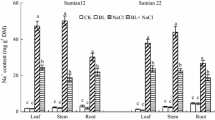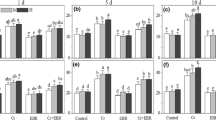Abstract
Heavy metals, including a hexavalent form of chromium (Cr(VI)) increasing accumulation in agricultural soil, cause a significant reduction in quality, yield, and growth of rice varieties worldwide. Screening for the selection of tolerant varieties is essential for conventional and molecular breeding. Shaheen basmati (SB) and basmati-385 (B-385) rice varieties, a subspecies of indica, show different sensitivity to Cr(VI), but the underlying mechanisms of this different sensitivity remain elusive. In the current study, we examine the sensitivity of SB and B-385 based on the root, which is the primary organ that encounters water and soil containing Cr(VI), elongation assay, and ethylene’s possible role (a stress-responsive phytohormone) in the process. Our results show that SB’s seedlings exhibit hypersensitivity as a higher root elongation inhibition than B-385 under different Cr(VI) concentrations. Hypersensitive SB consistently expresses a higher level of ethylene biosynthesis and signaling-related genes than B-385. Moreover, ethylene signaling antagonist (silver, Ag) and biosynthesis inhibitor (aminoethoxy vinyl glycine, AVG) alleviate the difference in Cr(VI)-induced root growth inhibition between SB and B-385, respectively. Taken together, we conclude that ethylene mediates difference in sensitivity based on the difference in root growth inhibition in different rice varieties.
Graphical abstract

The difference in Cr(VI)-induced root growth inhibition in SB and B-385. (A) Root growth of SB is slightly more as compared to B-385 in control conditions in the Hoagland solutions. (B) Seedlings of SB showed hypersensitivity to 200 μM Cr(VI) compared to B-385 in terms of primary root growth inhibition, which was higher in SB than B-385. Interestingly, Cr(VI)-induced relative transcript level of ethylene biosynthesis, perception, and signaling-related genes was significantly higher in hypersensitive SB than B-385. Current results in association with previous literature show that Cr(VI)-induced ethylene biosynthesis is regulating Cr(VI)-induced ethylene perception, signaling, and associated Cr(VI)-induced ethylene-mediated primary root growth inhibition. Conclusively, the difference in ethylene quantities in both varieties mediates the difference in root growth inhibition between SB and B-385 (C and E). The difference in Cr(VI)-induce root growth inhibition between SB and B-385 was significantly alleviated by ethylene signaling inhibitor (10 μM Ag, as AgNO3) and ethylene biosynthesis inhibitor (10 μM AVG) treatment in the presence of 200 μM Cr(VI), respectively. (D) Ethylene biosynthesis precursor (10 μM ACC) treatment-mediated induced root growth inhibition difference between SB and B-385 was not significant, which may be because of enough quantity of the Cr(VI)-mediated ethylene accumulation or unknown limiting factor. Arrows mean addition and an increase in expression, and T-line means suppression or inhibition. The width of the pointers (arrows) is proportional to the gene expression level.





Similar content being viewed by others
References
Abreu FRM, de Deus KE, Pereira WJ, Dias Silveira RD, Pereira Vianello R, Brondani C (2016) Expression of rice genes homologous of Arabidopsis genes previously related to drought tolerance. Aust J Crop Sci 10:1266–1272
Ali I, Liu B, Farooq MA, Islam F, Azizullah A, Yu C, Su W, Gan Y (2016) Toxicological effects of bisphenol A on growth and antioxidant defense system in Oryza saliva as revealed by ultrastructure analysis. Ecotoxicol Environ Saf 124:277–284
Ali I, Jan M, Wakeel A, Azizullah A, Liu B, Islam F, Ali A, Daud M, Liu Y, Gan Y (2017) Biochemical responses and ultrastructural changes in ethylene insensitive mutants of Arabidopsis thialiana subjected to bisphenol A exposure. Ecotoxicol Environ Saf 144:62–71
Awan S, Jabeen M, Imran QM, Ullah F, Mehmood Z, Jahngir M, Jamil M (2015) Effects of lead toxicity on plant growth and biochemical attributes of different rice (Oryza Sativa L.) varieties. Journal of Bio-Molecular Sciences 3:44–55
Bao S, An L, Su S, Zhou Z, Gan Y (2011) Expression patterns of nitrate, phosphate, and sulfate transporters in Arabidopsis roots exposed to different nutritional regimes. Botany-Botanique 89:647–653
Bashir K, Khan NM, Rasheed S, Salim M (2007) Indica rice varietal development in Pakistan: an overview. Paddy Water Environ 5:73–81
Cameron AC, Reid MS (2001) 1-MCP blocks ethylene-induced petal abscission of Pelargonium peltatum but the effect is transient. Postharvest Biol Technol 22:169–177
Chen Q, Wu K, Tang Z, Guo Q, Guo X, Wang H (2017) Exogenous ethylene enhanced the cadmium resistance and changed the alkaloid biosynthesis in Catharanthus roseus seedlings Acta Physiologiae Plantarum:39
Ditzler L, Breland TA, Francis C, Chakraborty M, Singh DK, Srivastava A, Eyhorn F, Groot JCJ, Six J, Decock C (2018) Identifying viable nutrient management interventions at the farm level: the case of smallholder organic Basmati rice production in Uttarakhand, India. Agric Syst 161:61–71
Ekman J, Clayton M, Biasi W, Mitcham E (2004) Interactions between 1-MCP concentration, treatment interval and storage time for ‘Bartlett’pears. Postharvest Biol Technol 31:127–136
Eleftheriou EP, Adamakis I-DS, Panteris E, Fatsiou M (2015) Chromium-induced ultrastructural changes and oxidative stress in roots of Arabidopsis thaliana. Int J Mol Sci 16:15852–15871
Gan Y-b, Zhou Z-j, An L-j, Bao S-j, Forde BG (2011) A comparison between northern blotting and quantitative real-time PCR as a means of detecting the nutritional regulation of genes expressed in roots of Arabidopsis thaliana. Agric Sci China 10:335–342
Helliwell EE, Wang Q, Yang Y (2016) Ethylene biosynthesis and signaling is required for rice immune response and basal resistance against Magnaporthe oryzae infection. Mol Plant-Microbe Interact 29:831–843
Hoagland DR, Arnon DI (1950) The water-culture method for growing plants without soil. Circular, California agricultural experiment station 347
Lee HY, Yoon GM (2018) Regulation of ethylene biosynthesis by phytohormones in etiolated rice (Oryza sativa L.) seedlings. Mol Cell 41:311
Li J, Xu H-H, Liu W-C, Zhang X-W, Lu Y-T (2015) Ethylene inhibits root elongation during alkaline stress through AUXIN1 and associated changes in auxin accumulation. Plant Physiol 168:1777–U1154
Malook I, Shah G, Jan M, Shinwari KI, Aslam MM, Rehman SU, Jamil M (2017) Smoke priming regulates growth and the expression of myeloblastosis and zinc-finger genes in rice under salt stress. Arab J Sci Eng 42:2207–2215
Pfaffl MW (2012): Quantification strategies in real-time polymerase chain reaction. Quantitative Real-time PCR in Applied Microbiology, 53-61 pp
Schellingen K, Van Der Straeten D, Remans T, Vangronsveld J, Keunen E, Cuypers A (2015) Ethylene signalling is mediating the early cadmium-induced oxidative challenge in Arabidopsis thaliana. Plant Sci 239:137–146
Shinwari KI, Jan M, Shah G, Khattak SR, Urehman S, Daud M, Naeem R, Jamil M (2015) Seed priming with salicylic acid induces tolerance against chromium (VI) toxicity in rice (Oryza sativa L.). Pak J Bot 47:161–170
Steffens B (2014) The role of ethylene and ROS in salinity, heavy metal, and flooding responses in rice. Front Plant Sci 5:685
Sun P, Tian Q-Y, Chen J, Zhang W-H (2010) Aluminium-induced inhibition of root elongation in Arabidopsis is mediated by ethylene and auxin. J Exp Bot 61:347–356
Sun L, Zhang A, Zhou Z, Zhao Y, Yan A, Bao S, Yu H, Gan Y (2015) Glabrous Inflorescence Stems 3 (GIS 3) regulates trichome initiation and development in Arabidopsis. New Phytologist 206(1):220–230
Wakeel A, Xu M (2020) Chromium Morpho-Phytotoxicity. Plants 9:564
Wakeel A, Ali I, Upreti S, Azizullah A, Liu B, Khan AR, Huang L, Wu M, Gan Y (2018) Ethylene mediates dichromate-induced inhibition of primary root growth by altering AUX1 expression and auxin accumulation in Arabidopsis thaliana. Plant Cell Environ 41:1453–1467
Wakeel A, Ali I, Wu M, Kkan AR, Jan M, Ali A, Liu Y, Ge S, Wu J, Gan Y (2019) Ethylene mediates dichromate-induced oxidative stress and regulation of the enzymatic antioxidant system-related transcriptome in Arabidopsis thaliana. Environ Exp Bot 161:166–179
Wakeel A, Xu M, Gan Y (2020) Chromium-induced reactive oxygen species accumulation by altering the enzymatic antioxidant system and associated cytotoxic, genotoxic, ultrastructural, and photosynthetic changes in plants. Int J Mol Sci 21:728
Wang Q, Zhang W, Yin Z, Wen C-K (2013) Rice CONSTITUTIVE TRIPLE-RESPONSE2 is involved in the ethylene-receptor signalling and regulation of various aspects of rice growth and development. J Exp Bot 64:4863–4875
Yamauchi T, Tanaka A, Mori H, Takamure I, Kato K, Nakazono M (2016) Ethylene-dependent aerenchyma formation in adventitious roots is regulated differently in rice and maize. Plant Cell Environ 39:2145–2157
Yang C, Li W, Cao J, Meng F, Yu Y, Huang J, Jiang L, Liu M, Zhang Z, Chen X, Miyamoto K, Yamane H, Zhang J, Chen S, Liu J (2017) Activation of ethylene signaling pathways enhances disease resistance by regulating ROS and phytoalexin production in rice. Plant J 89:338–353
Yu X-Z, Lin Y-J, Fan W-J, Lu M-R (2017) The role of exogenous proline in amelioration of lipid peroxidation in rice seedlings exposed to Cr(VI). Int Biodeterior Biodegradation 123:106–112
Yuan R, Carbaugh DH (2007) Effects of NAA, AVG, and 1-MCP on ethylene biosynthesis, preharvest fruit drop, fruit maturity, and quality of ‘Golden Supreme’and ‘Golden Delicious’ apples. HortScience 42:101–105
Yuan H-M, Huang X (2016) Inhibition of root meristem growth by cadmium involves nitric oxide-mediated repression of auxin accumulation and signalling in Arabidopsis. Plant Cell Environ 39:120–135
Yuan R, Li J (2008) Effect of sprayable 1-MCP, AVG, and NAA on ethylene biosynthesis, preharvest fruit drop, fruit maturity, and quality of ‘Delicious’ apples. HortScience 43:1454–1460
Zhang S, Huang L, Yan A, Liu Y, Liu B, Yu C, Zhang A, Schiefelbein J, Gan Y (2016) Multiple phytohormones promote root hair elongation by regulating a similar set of genes in the root epidermis in Arabidopsis. J Exp Bot 67:6363–6372
Zhou Z, Sun L, Zhao Y, An L, Yan A, Meng X, Gan Y (2013) Zinc Finger Protein 6 (ZFP 6) regulates trichome initiation by integrating gibberellin and cytokinin signaling in A rabidopsis thaliana. New Phytologist 198(3):699–708
Availability of data and materials
Not applicable
Funding
The research was supported by Major State Basic Research Development Program the National Key R & D Program of China (2016YFD0100701), the Leading Innovative and Entrepreneur Team Introduction Program of Zhejiang (2019R01002) and Zhejiang Provincial Natural Science Foundation of China (LQ19C130004) and the National Natural Science Foundation of China (Grant No. 31570183; 31529001; 31661143004).
Author information
Authors and Affiliations
Contributions
1. Abdul Wakeel: conception or design of the work, experimental work, data collection, data analysis and interpretation, and drafting the article
2. Imran Ali: experimental work and critical revision of the article
3. Minjie Wu: experimental work
4. Bohan Liu: experimental work
5. Yinbo Gan: final approval of the version to be published
Corresponding author
Ethics declarations
Ethics approval and consent to participate
Not applicable
Consent for publication
Not applicable
Competing interests
The authors declare no competing interests.
Additional information
Responsible Editor: Gangrong Shi
Publisher’s note
Springer Nature remains neutral with regard to jurisdictional claims in published maps and institutional affiliations.
Rights and permissions
About this article
Cite this article
Wakeel, A., Ali, I., Wu, M. et al. Dichromate-induced ethylene biosynthesis, perception, and signaling regulate the variance in root growth inhibition among Shaheen basmati and basmati-385 rice varieties. Environ Sci Pollut Res 28, 38016–38025 (2021). https://doi.org/10.1007/s11356-021-13477-6
Received:
Accepted:
Published:
Issue Date:
DOI: https://doi.org/10.1007/s11356-021-13477-6




